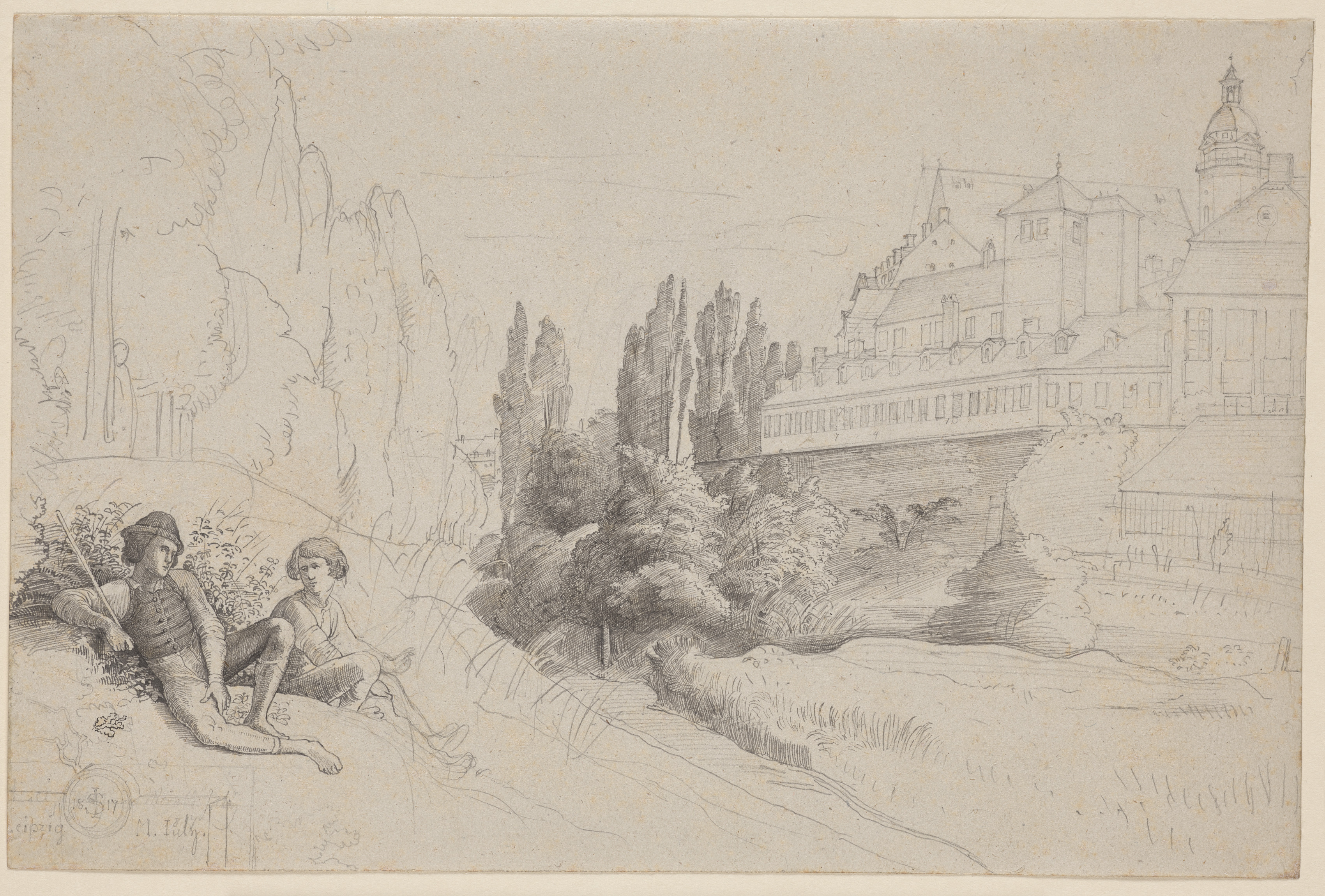The Cleveland Museum of Art
Collection Online as of April 23, 2024

View across the Moat towards the Thomasschule and the Thomaskirche in Leipzig
1817
(German, 1794–1872)
Sheet: 15.7 x 23.8 cm (6 3/16 x 9 3/8 in.)
Location: not on view
Did You Know?
The landscape in this drawing is seen from the perspective of Schnorr von Carolsfeld’s family home in Leipzig.Description
Julius Schnorr von Carolsfeld belonged to the Nazarenes, a group of artists who looked to early Northern Renaissance art for its simplicity and piety. The artist created this drawing during a visit to his native Leipzig en route to join the Nazarenes in Rome. He depicted the city’s distinctive features, including the oldest German language school in Europe (of which he was an alumnus) and a church where Johann Sebastian Bach served as cantor during the 18th century. The artist himself appears in a self-portrait at right in the pair seen at lower left. He juxtaposed loosely sketched landscape with areas of profuse detail, created with a hard and sharpened pencil reinforced with pen and ink.- For this work on wove paper, Schnorr von Carolsfeld established the composition as a line drawing using a pale silvery-gray graphite pencil. Then to shade and strengthen the wooded area at the center of the composition and the two figures in the left foreground, he went over the graphite with pen and gray-black ink using outline and a regimented system of hatching and crosshatching with a strong right-handed directional. Establishing two focal points with a second darker medium—in this case one that resembles dark graphite—does not however overwhelm the more delicately rendered elements, including the cursorily drawn landscape and trees on the left and detailed architecture representing the Thomasschule on the right. A sure and steady hand is evident in the detailed and complex architectural structures; it is also apparent that many of their rectilinear elements were gone over with a graphite line applied with the aid of a straight edge. The figure bearing a likeness to the artist in his youth shows numerous corrections in graphite to the proper left arm, leg, and foot.
Several observations bring up the possibility that Schnorr von Carolsfeld made this drawing with the aid of a camera lucida, an optical drawing instrument recommended for mastering perspective and topographical accuracy in landscape, as well as capturing likenesses for portraiture. (Sir William Hyde Wollaston’s popular prism camera lucida was invented in 1807.) With this instrument an initial sketch is made by tracing a virtual image reflected on paper. (The camera obscura, an earlier optical drawing aid still in use at this time, works by casting a real image onto a surface which then can be traced.)
When working with the camera lucida artists often drew over the initial sketch with a second linear medium to correct, reinforce, and realize a more finished drawing, but in doing so many of the subtle and quirky clues inherent to the camera lucida line were lost. Clearly a good portion of this composition was gone over, aligning with this practice.
Therefore, it is the unmodified line seen in the tree growth in left background and defining the middle grassy bank that arguably bears the most compelling evidence of the use of a camera lucida. This portion of the composition captures the habit of a traced line—specifically a line tracing a tenuous reflected image—to meander falteringly through a view with awkward starts and stops and illogical transitions. - Eduard Cichorius [1819–1907], Dresden, GermanyProfessor Ludwig Schnorr von Carolsfeld [1877–1945], Berlin, the artist’s grandson?-1945Carl Heumann [1886–1945], Chemnitz, Germany1945–57Carl Heumann EstateNovember 29, 1957(Carl Heumann posthumous collection sale, Stuttgarter Kunstkabinett, no. 320, sold to Erhard Göpel), 19571957–66Erhard Göpel [1906–1966], Munich, Germany1966-?By descent to his wife, Barbara Göpel [1922–2017], Munich, Germany1994-2019Private Collection, Germany2019–22(Daxer & Marschall Kunsthandels, Munich, Germany, sold to the Cleveland Museum of Art, Cleveland, OH)2022-The Cleveland Museum of Art, Cleveland, OH,
- Deutsche Landscaftskunst, 1750–1850: Zeichnungen und Aquarelle aus der Sammlung Heumann, Chemnitz. Exh. Cat. Breslau: Schlesisches Museum der Bildenden Künste, 1933. Mentioned no. 135Zeichenkunst der deutschen Romantik. Exh. Cat. Wiesbaden: Nassauisches Landesmusuem, 1937. Mentioned: 30, no. 282Göpel, Erhard. “Deutsche Künstler zeichnen in Leipzig.” Leipziger Jahrbuch 14 (1939). Mentioned p. 134–36Kunst des 18. und 19. Jahrhunderts: Sammlung Heumann, Chemnitz. Stuttgart: Stuttgarter Kunstkabinetts, 1957. Mentioned: p. 66, no. 320; Reproduced: pl. 18Göpel, Erhard. “Eine unbekannte Ansicht Leipzigs” Neue Lepipziger Zeitung 249, no. 6 (September 6, 1933). reproducedMehnert, Karl Hein. “Eine wiederentdeckte Stadtansicht: Zur Ausstellung Julius Schnorr von Carolsfeld im Museum der bildenden Künste.” Leipziger Blatter 27 (Spring 1994). Reproduced: p. 74; Mentioned: p. 75.Julius Schnorr von Carolsfeld, 1794–1872. Exh. Cat. Leipzig: Museum der Bildenden Künste, 1994. Mentioned: 197–98, no. 27; Reproduced: p. 97
- Julius Schnorr von Carolsfeld, 1794–1872. Museum der Bildenden Künste, Leipzig (March 26–May 23, 1994); Kunsthalle Bremen, Germany (June 5–July 31, 1994).Zeichenkunst der deutschen Romantik. Nassauisches Landesmusuem, Wiesbaden, Germany (May–mid-July 1937)Deutsche Landscaftskunst, 1750–1850: Zeichnungen und Aquarelle aus der Sammlung Heumann, Chemnitz. Schlesisches Museum der Bildenden Künste, Breslau, Poland (1933).
- {{cite web|title=View across the Moat towards the Thomasschule and the Thomaskirche in Leipzig|url=false|author=Julius Schnorr von Carolsfeld|year=1817|access-date=23 April 2024|publisher=Cleveland Museum of Art}}
Source URL:
https://www.clevelandart.org/art/2022.1